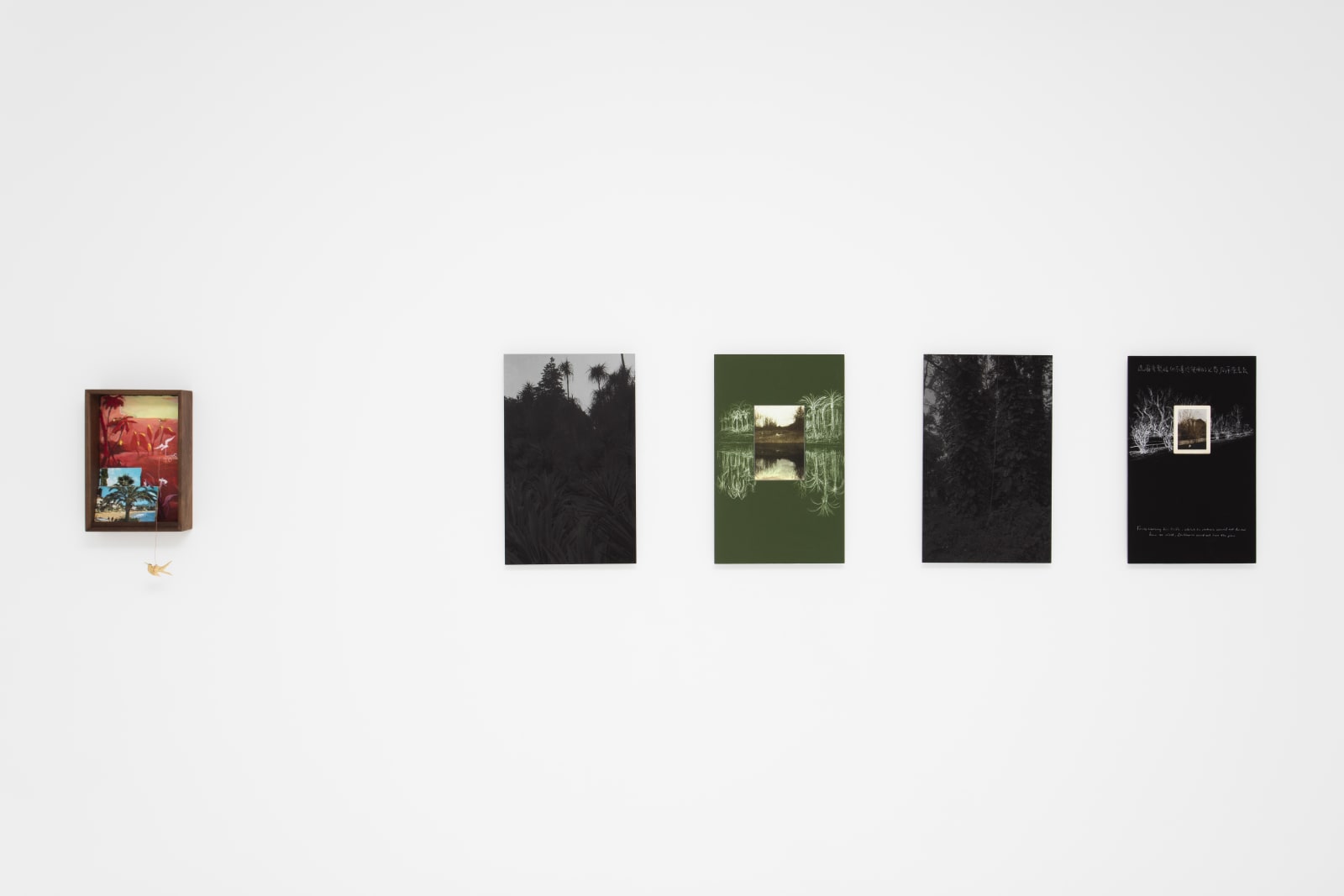Chen Dandizi 陈丹笛子
"The South" "南方", 2016
oil painting on wood, found objects, postcards, ink-jet prints, 木板油画、物件、明信片、收藏级数码微喷
ink-jet prints 收藏级数码微喷 54.5 x 34 cm x 4, wood box 木盒 36 x 24 x 8 cm
Edition of 3 plus 1 AP
He was sitting in a small Café unfolding a letter from his old-time lover who lived in the south. The Café had mirrors all over its three walls. The letter,...
He was sitting in a small Café unfolding a letter from his old-time lover who lived in the south. The Café had mirrors all over its three walls. The letter, was it from the lover whom he missed, or was it from the South that he missed? They lived in the cold north that their rooftop installed a weathercock. His daughter had never been to the South, she only knew that her father came from there, and she could only imagine the south through landscape postcards. Later on, the father committed suicide; and his profoundly endless desire towards the South was inherited by his daughter. (“El Sur”, the Spanish movie directed by Victor Erice, 1983)
I live in south China, the southern part in the traditional geographical sense. Many countries have their own division between South and North; thus, each pair of South/North has an invisible sideline. This“invisible sideline”, just like the “Invisible Cities” by Italo Calvino, is all about conceptions -- the more “invisible”, the more mysterious and unsettling it gets… I gathered several phrases from my impressions on the South: muggy weather, no snow, sudden storms, leaves of palm tree, migratory birds, abundant sunshine, lush vegetation, crowds of naked arms and legs… Combining a couple of the phrases mentioned before would be enough for us to construct a scene of the South in imagination; same as the little girl from “El Sur”, who imagines about “the South” of her father through various postcards. (Objects reappeared in the artwork: a wooden box on wall, a collection of postcards depicting sceneries of the Southern Spain, a brass broach of southward swallow, and child-like hand-painted patterns.)
“The South” is also the title of a fictional short story by Jorge Luis Borges. Similar to the movie “El Sur”, Borges’s novel “The South” also focuses on dream, death, destiny, and eternality, while it has a variety of interpretations as well. However, no matter what kind of interpretation we take, the thing that stands at the far yet clear edge of the story is the desirable South. What is this so-called South? Does it represent a foreign land? For me, it is not a simple myth about strange places, nor does it serve as an exit for nihilism or lies. In both “El Sur” and Borges’s story, “the South” becomes the symbol resembling a sense of belongingness and mystery. Coincidentally, the two protagonists had put their secrets and spiritual bailments into the South, and in turn, the South becomes the desire embedded with deep tortures and repeated narratives for them. Therefore, “the South” never has a visible boundary, it is not a concrete area, but a misty idea -- and all of a sudden, I believe that there exists an unknown “South” waiting for me, beyond where I live.
他坐在一家狭小的咖啡厅里,展开一封过去在南方时他的情人的来信。咖啡厅三面墙都是镜子。他收到的来信到底是来自他所怀念的八九年前的那位情人,还是来自他所迫切思念的南方。他们住在寒冷的北方,那个城市他们的屋顶上有只公鸡图案的风向标,他的女儿从来没有到过南方,只知道她的父亲来自南方,她只能依赖各种与自己生活的环境截然不同的风景明信片来想象南方。后来父亲自杀,他对南方那深刻的未尽的欲望就被女儿所继承下来。(《南方(El Sur)》,1983年西班牙电影,导演:Victor Erice)
我生活在国家(中国)的南部,是个传统地理意义上的南方地区。很多国家都有自己的一个南北方的划分,于是在每一对南方北方之间,就有一条看不清的边线,这条“看不清的边线”长得就像“卡尔维诺所有的看不见的城市”一样,皆是关于概念的。越“看不清”,则越神秘荡漾……我在自己的印象里寻找到一些提起南方就会想到的词句:湿热的气候、无雪、突如其来的暴雨、棕榈树的叶子、迁徙的鸟、充足的阳光、茂密的植被、热烈的裸露着四肢的人群……这些词只要三两个组合在一起,便足以让我们构成一个可供想象的南方的外貌,电影《El Sur》中的小女孩就是通过明信片上这样生硬而直接的组合来想象她父亲心中的“南方”的。(作品中的物件重现:壁挂木盒、收集的一叠描绘西班牙南部的风景明信片、南迁的燕子的黄铜胸针,孩童似的手绘图案)
名为《南方》的故事还有来自博尔赫斯的一篇虚构的短篇小说,与上面这部电影相似,博尔赫斯的《南方》的关注点也在于梦境、死亡、归宿、永恒等字眼上,这个故事也可以有多种解释版本。但无论以何种方式解读,伫立在故事遥远而清晰的边缘的,正是令人渴望的南方。我会想这所谓的南方情节到底是什么,是异乡么?我想,它并不是一个简单的对异乡的迷思,也并不用来化作虚无或谎言一般的出口,在《El Sur》和博尔赫斯的《南方》之中,“南方”都成为了归属感和神秘感的代言,它们的主人公的内心都有着那一份秘密和寄托,然而,非常巧合的是,这些东西往往都牵挂于南方,成为一份深深折磨着他们的、反复诉说的渴望。于是乎,“南方”永远看不到边际,因为它不是一块实体的区域,它是一团缥缈的念头——突然让我相信,在我自己所居住的南方之外,还有一个不知名的“南方”在等待着我了。
I live in south China, the southern part in the traditional geographical sense. Many countries have their own division between South and North; thus, each pair of South/North has an invisible sideline. This“invisible sideline”, just like the “Invisible Cities” by Italo Calvino, is all about conceptions -- the more “invisible”, the more mysterious and unsettling it gets… I gathered several phrases from my impressions on the South: muggy weather, no snow, sudden storms, leaves of palm tree, migratory birds, abundant sunshine, lush vegetation, crowds of naked arms and legs… Combining a couple of the phrases mentioned before would be enough for us to construct a scene of the South in imagination; same as the little girl from “El Sur”, who imagines about “the South” of her father through various postcards. (Objects reappeared in the artwork: a wooden box on wall, a collection of postcards depicting sceneries of the Southern Spain, a brass broach of southward swallow, and child-like hand-painted patterns.)
“The South” is also the title of a fictional short story by Jorge Luis Borges. Similar to the movie “El Sur”, Borges’s novel “The South” also focuses on dream, death, destiny, and eternality, while it has a variety of interpretations as well. However, no matter what kind of interpretation we take, the thing that stands at the far yet clear edge of the story is the desirable South. What is this so-called South? Does it represent a foreign land? For me, it is not a simple myth about strange places, nor does it serve as an exit for nihilism or lies. In both “El Sur” and Borges’s story, “the South” becomes the symbol resembling a sense of belongingness and mystery. Coincidentally, the two protagonists had put their secrets and spiritual bailments into the South, and in turn, the South becomes the desire embedded with deep tortures and repeated narratives for them. Therefore, “the South” never has a visible boundary, it is not a concrete area, but a misty idea -- and all of a sudden, I believe that there exists an unknown “South” waiting for me, beyond where I live.
他坐在一家狭小的咖啡厅里,展开一封过去在南方时他的情人的来信。咖啡厅三面墙都是镜子。他收到的来信到底是来自他所怀念的八九年前的那位情人,还是来自他所迫切思念的南方。他们住在寒冷的北方,那个城市他们的屋顶上有只公鸡图案的风向标,他的女儿从来没有到过南方,只知道她的父亲来自南方,她只能依赖各种与自己生活的环境截然不同的风景明信片来想象南方。后来父亲自杀,他对南方那深刻的未尽的欲望就被女儿所继承下来。(《南方(El Sur)》,1983年西班牙电影,导演:Victor Erice)
我生活在国家(中国)的南部,是个传统地理意义上的南方地区。很多国家都有自己的一个南北方的划分,于是在每一对南方北方之间,就有一条看不清的边线,这条“看不清的边线”长得就像“卡尔维诺所有的看不见的城市”一样,皆是关于概念的。越“看不清”,则越神秘荡漾……我在自己的印象里寻找到一些提起南方就会想到的词句:湿热的气候、无雪、突如其来的暴雨、棕榈树的叶子、迁徙的鸟、充足的阳光、茂密的植被、热烈的裸露着四肢的人群……这些词只要三两个组合在一起,便足以让我们构成一个可供想象的南方的外貌,电影《El Sur》中的小女孩就是通过明信片上这样生硬而直接的组合来想象她父亲心中的“南方”的。(作品中的物件重现:壁挂木盒、收集的一叠描绘西班牙南部的风景明信片、南迁的燕子的黄铜胸针,孩童似的手绘图案)
名为《南方》的故事还有来自博尔赫斯的一篇虚构的短篇小说,与上面这部电影相似,博尔赫斯的《南方》的关注点也在于梦境、死亡、归宿、永恒等字眼上,这个故事也可以有多种解释版本。但无论以何种方式解读,伫立在故事遥远而清晰的边缘的,正是令人渴望的南方。我会想这所谓的南方情节到底是什么,是异乡么?我想,它并不是一个简单的对异乡的迷思,也并不用来化作虚无或谎言一般的出口,在《El Sur》和博尔赫斯的《南方》之中,“南方”都成为了归属感和神秘感的代言,它们的主人公的内心都有着那一份秘密和寄托,然而,非常巧合的是,这些东西往往都牵挂于南方,成为一份深深折磨着他们的、反复诉说的渴望。于是乎,“南方”永远看不到边际,因为它不是一块实体的区域,它是一团缥缈的念头——突然让我相信,在我自己所居住的南方之外,还有一个不知名的“南方”在等待着我了。


